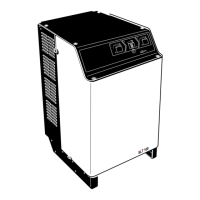1
1115.GB
A Correct use and application
The SLT 100 battery charger is designed
for the fully automatic charging of lead
batteries and may only be operated for this
purpose. The charger operates in
accordance with the Wa characteristic
specified in DIN 41774. This characteristic
is optimized by current pulses at the end of
the charge. This current characteristic
curve, which slopes downwards as the
battery charge level rises, allows for optimal
charging. Safe functioning of the battery
charger is ensured by the reliable charging
electronics monitoring the battery charging
operation.
The technical data and specifications
regarding the connection requirements can
be found on the identification plate and in
the operating instructions. These
specifications must always be heeded.
Operation of the battery chargers is subject
to the provisions contained in the relevant
legislation and regulations, from industry
association guidelines (VDE), from the
EMC directive (2004/108/EC) and
directives issued by local authorities.
Excerpts of such provisions are given in
chapter E1.
The battery charger must only be used for
charging batteries which are of the type
stipulated by the manufacturer.
The battery charger must always be
operated with the housing closed. It is
forbidden to loosen and remove parts of the
housing or any type of suppressor
elements.
Do not place any objects on the charger or
climb onto it.
Additional components may only be
installed after a written approval by the
manufacturer has been obtained.
User obligations:
User within the meaning of these operating
instructions is any natural person or legal
person who either uses the battery charger
himself, or on whose behalf it is used.
In special cases (e.g. leasing or renting),
the user is deemed to be the person, who,
in accordance with existing contractual
agreements between the owner and the
user of the SLT 100 battery charger, is
charged with the observance of the
operating duties.
The user is responsible for choosing the
assembly location. He must check whether
the battery charger will affect any devices
that are sensitive to electromagnetic
interference.
The assembly location of the charger must
be chosen so that operation (high DC
currents generate magnetic interference
fields) does not affect the functioning of
sensitive electromagnetic devices and
magnetic data media, such as
pacemakers, monitors, disks, magnetic
tapes, magnetic cards, watches, see
“Charger Assembly” on page 5.
The user must ensure that the SLT 100
battery charger is used only within its
design limits and that all danger to life and
limb of the operator and third parties is
avoided.
Furthermore, applicable accident
prevention and other health and safety
regulations, along with the operating and
maintenance guidelines, must be observed
at all times.
M
The battery charger must only be operated
when stationary.
The user must also ensure that all persons
operating the battery chargers have read
and understood these operating
instructions.
16
1115.GB
7 Aid for malfunctions
F
Faults may only be rectified by skilled
electricians in compliance with safety
regulations. Remove the battery and mains
plugs before opening the charger.
Z
This chapter enables the user to localize
and rectify basic faults or the results of
incorrect operation himself.
7.1 Malfunction: Pump does not react
during charging.
Possible causes:
- The cables are not connected tightly
enough.
- Fuse (2) faulty.
Elimination measures:
- Connect the cables tightly.
- Check fuse (2) and replace if necessary
(1 AT).
7.2 Malfunction: Charging time is not
reduced
Possible causes:
- The hose system is defective
(see “Air pressure monitor” on page 14).
- Filter (5) is clogged.
Elimination measures:
- Replace the hose system.
- Replace filter (5).
7.3 Malfunction: Loud pump noises
Possible causes:
- The hose system is defective
(see “Air pressure monitor” on page 14).
- Filter (5) is clogged.
Elimination measures:
- Replace the hose system.
- Replace filter (5).
Z
If the charger cannot be restored to
operational status after carrying out the
remedial operations, contact the
manufacturer’s service department.
Further remedial work should only be
carried out by the manufacturer’s trained
service personnel. The manufacturer’s
service department has field technicians
specially trained for these tasks.
12
3
4

